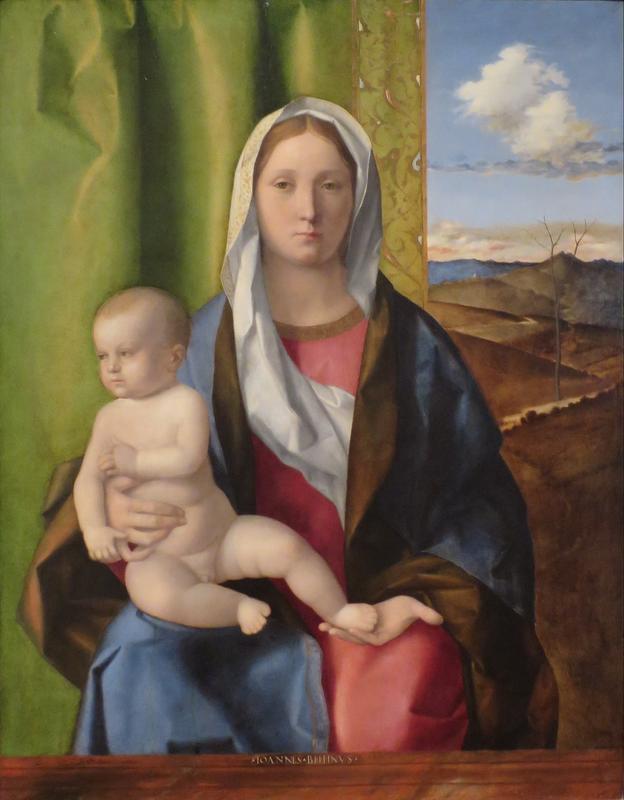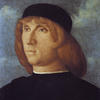More about Madonna and Child

Contributor
Madonna and Child? During the Italian Renaissance? Groundbreaking.
But really! Venetian painter Giovanni Bellini combined elements of Byzantine icons and Florentine naturalism to create his *chef’s kiss* signature style. This work is oil on canvas, a medium Bellini championed in the early Italian Renaissance. Roughly forty years before creating this painting, he radically moved away from the traditional Italian technique of egg tempera to oil paint, inspired by Flemish painting, resulting in a technical revolution that would have profound consequences for the history of European art. The best thing until sliced bread came around. The use of oil paint allowed him to better capture slight variations in color and shadow, as seen here on Mary’s face.
In Madonna and Child, and many of Bellini's other works of the same subject, the mother and son appear emotionally distant, despite his position on her lap. This may be understood as Mary’s premonition of her son’s fate. In a time of devastating infant mortality rates, contemporary viewers would have been able to deeply relate. The scraggly tree in landscape behind them also hints at sweet baby Jesus’ future, alluding to the crucifixion and the Tree of Knowledge from the Garden of Eden. But there is hope! The green tapestry behind them, called a cloth of honor, signifies renewal. In addition to their expressions being cold and distant, Bellini’s Madonna and Child also features a small ledge at the bottom that separates their sacred world from the viewer’s mortal world. On this ledge, we can also see the artist’s signature.
Orville and Wilbur Wright, John and Ted Kennedy, heck Dylan and Cole Sprouse - there are a plethora of famous brothers throughout history, including Giovanni, his brother Gentile, and their brother-in-law Andrea Mantegna. However, one brother looms larger than the others. Looking at his Madonna and Child, it’s no mystery why Giovanni was the rock star of the early Venetian Renaissance painting scene. Painted at the age of 80, Giovanni was a well established and renowned painter by the time he made this work. He and his workshop cranked out countless Madonna and Child paintings, which were intended for Italians’ private devotion. Bellini was active for nearly seventy years with well over 220 surviving paintings attributed to him. If you are thinking, “That’s a whole lot of paintings, even for someone actively working at age 80,” you’re not alone. (If you’re also thinking, “I’m barely 30 and couldn't possibly be described as active,” you’re also not alone.) By 1500, employing numerous assistants, he headed what was probably the largest painter’s workshop in Italy. Artists in his shop worked from his sketches to create variations and copies of paintings actually painted by his hand. As one art historian puts it, “No one with eyes has ever believed that all of the signed paintings were actually by Bellini.”
Sources
- Bellini, Giovanni, Goffen, Rona. Giovanni Bellini. United Kingdom: Yale University Press, 1989. https://www.getty.edu/art/collection/artists/2974/giovanni-bellini-ital… https://www.google.com/books/edition/Giovanni_Bellini_Illustr_N
- “Bellini’s Luminous Madonnas,” Italian Renaissance Learning Resources, Accessed March 13, 2021, http://www.italianrenaissanceresources.com/units/unit-1/essays/bellinis…
- Goffen, Rona. "Icon and Vision: Giovanni Bellini's Half-Length Madonnas." The Art Bulletin 57, no. 4 (1975): 487-518. Accessed March 13, 2021. doi:10.2307/3049433.
- Humfrey, Peter ed. The Cambridge Companion to Giovanni Bellini. Cambridge University Press. United Kingdom, 2004. https://web.archive.org/web/20110912025236/http://assets.cambridge.org/…
- “Madonna and Child,” High Museum of Art, Accessed March 13, 2021, https://high.org/collections/madonna-and-child/.











